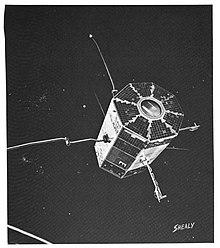OV3-2
USAF | |
| COSPAR ID | 1966-097A |
|---|---|
| SATCAT no. | S02517 |
| Spacecraft properties | |
| Manufacturer | Space General |
| Launch mass | 81 kg (179 lb)[1] |
| Start of mission | |
| Launch date | 28 October 1966 11:56:02 UTC |
| Rocket | Scout B |
| Launch site | Vandenberg Space Launch Complex 5[2] |
| End of mission | |
| Decay date | 29 September 1971 |
| Orbital parameters | |
| Regime | Medium Earth Orbit |
| Eccentricity | 0.08697 |
| Perigee altitude | 320.00 km (198.84 mi) |
| Apogee altitude | 1,597.00 km (992.33 mi) |
| Inclination | 82.000° |
| Period | 104.20 minutes [3] |
| Epoch | 28 October 1966 12:00:00 |
Orbiting Vehicle 3-2 (also known as OV3-2
History
The Orbiting Vehicle satellite program arose from a US Air Force initiative, begun in the early 1960s, to reduce the expense of space research. Through this initiative, satellites would be standardized to improve reliability and cost-efficiency, and where possible, they would fly on test vehicles or be piggybacked with other satellites. In 1961, the Air Force Office of Aerospace Research (OAR) created the Aerospace Research Support Program (ARSP) to request satellite research proposals and choose mission experiments. The USAF Space and Missiles Organization created their own analog of the ARSP called the Space Experiments Support Program (SESP), which sponsored a greater proportion of technological experiments than the ARSP.[4]: 417 Five distinct OV series of standardized satellites were developed under the auspices of these agencies.[4]: 425
Unlike the previously initiated OV1 and OV2 series of satellites, which were designed to use empty payload space on rocket test launches, the six OV3 satellites all had dedicated Scout boosters. In this regard, the OV3 series was more akin to its civilian science program counterparts (e.g. Explorer). OV3 differed from NASA programs in its heavy use of off-the-shelf equipment, which resulted in lower unit cost.[4]: 422–423
The first four satellites in the series were made the Aerojet subsidiary Space General Corporation under a $1.35m contract awarded 2 December 1964, the first satellite due October 1965. The last two satellites were built by Air Force Cambridge Research Laboratory (AFCRL), which also managed the entire series and provided four of the OV3 payloads.[4]: 422–423

Charles H. Reynolds, who worked at AFCRL from 1955, was the technical manager for the OV3 program.[5]
Prior to the launch of OV3-2, three other OV3 satellites had been placed into orbit, all radiation measuring spacecraft launched in 1966.[4]: 423 [2]
Spacecraft design
Like the rest of the OV3 satellites, OV3-2 was an octagonal prism, .74 m (2 ft 5 in) in length and width, with experiments mounted on booms. 2560 solar cells provided 30 Watts of power. The satellite was spin-stabilized, but because it was asymmetrical once its booms were extended,[6] OV3-2 maintained its attitude in orbit with a precession damper.[4]: 422–423 The spacecraft was spin stabilized at eigtht revolutions per minute (rpm)[3] A Sun sensor, as well as an onboard tri-axial magnetnometer, gave information on the satellite's aspect (facing), its spin rate, and rate of precession.[7][4]: 423
OV3-2 massed 81 kg (179 lb)[1] Its design life-span was one year.[4]: 423
Experiments
OV3-2 carried five AFCRL experiments designed primarily to investigate low-energy particles in the
Joseph H. Geary was the payload manager for OV3-2.[7]
Mission

Launched from
As a result of the erratic performance of the command system, tape recorded data was not obtained until orbit 58 (four days after launch).[3] In 1967, the tape recorder failed, and an additional command system at Churchill, Manitoba was set up to obtain real-time data.[10] This data had to be manually reduced for interpretation because of a malfunction of OV3-2's onboard clock. Some RPA data was lost due to the failure of the thermal equalization probe.[3] The satellite operated throughout 1967,[9] returning high quality data.[8]
The satellite was tracked from the ground from January 1967 to March 1969, a period of rising solar activity, to determine atmospheric densities at heights of 275 km (171 mi) and 320 km (200 mi). The deduced values were compared to those returned by Explorer 32, also in orbit at the time. Good data were obtained.[3]
OV3-2 reentered the Earth's atmosphere on 29 September 1971.[11]
Legacy
The OV3 program ultimately comprised 6 missions, five of them successful. The last (OV3-6) flew on 4 December 1967.[2] The OV3 program was terminated following OV3-6 in favor of the cheaper OV1 program.[4]: 423
References
- ^ a b William R. Corliss (1967). Scientific Satellites. Washington D.C.: Science and Technical Information Division, Office of Technology Utilization, NASA. p. 774. Retrieved 1 April 2021.
- ^ a b c d McDowell, Jonathan. "Launch Log". Jonathan's Space Report. Retrieved 27 September 2021.
- ^ a b c d e f g h i "OV3-2". NASA. Retrieved 27 September 2021.
- ^ a b c d e f g h i j k l Powell, Joel W.; Richards, G.R. (1987). "The Orbiting Vehicle Series of Satellites". Journal of the British Interplanetary Society. Vol. 40. London: British Interplanetary Society.
- ^ Charles H. Reynolds (July 1967). "Anniversary of OV3-1". research review. Vol. 6, no. 7. Office of Aerospace Research. pp. 10–11. Retrieved 1 April 2021.
- ^ George A. Kuck (August 1968). Low-Energy Auroral Electrons Measured by Satellite OV3-1. Retrieved 8 June 2021.
- ^ a b c d e "AFCRL covers November 1966 Eclipse". Research Review. Vol. 6, no. 2. Office of Aerospace Research. February 1967. pp. 4–5.
- ^ OCLC 316861363.
- ^ OCLC 14475382.
- ^ OCLC 69188216.
- ^ McDowell, Jonathan. "Satellite Catalog". Jonathon's Space Report. Retrieved 27 September 2021.
